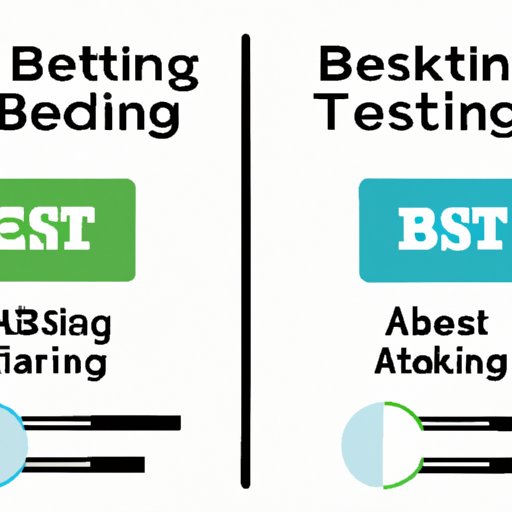
I. Introduction
In today’s competitive world, it is essential for businesses to stay ahead of the game. A/B testing is an effective tool that can help businesses gain valuable insights into their marketing strategies and optimize their performance. This article aims to provide a beginner’s guide to A/B testing in marketing to help businesses harness its power and stay ahead of their competition.
II. The Beginner’s Guide to A/B Testing
A/B testing, also known as split testing, is a process of comparing two versions of a marketing element to determine which one performs better. This technique can be applied to various marketing elements such as email subject lines, landing pages, website designs, and many more.
There are different types of A/B testing such as A/B/C testing, multivariate testing, and split URL testing. A/B/C testing involves testing three variations of a marketing element, while multivariate testing involves testing multiple elements simultaneously. Split URL testing involves creating two or more versions of a website and splitting the traffic randomly between them.
A/B testing can help businesses optimize their marketing campaigns and increase conversions. For instance, a business can test two different email subject lines and send them to different segments of its email list. By measuring the open rates of both subject lines, the business can determine which one performs better and use it in its future email campaigns.
III. How to Implement A/B Testing into Your Marketing Strategy
The process of implementing A/B testing into your marketing strategy involves the following steps:
Step 1: Define your goals – Before starting an A/B test, you should define your goals and what you hope to achieve. This will help you choose the right element to test and measure the right metrics.
Step 2: Choose what to test – Once you have defined your goals, you need to choose what marketing element to test. It can be anything from email subject lines to landing page designs.
Step 3: Create variations – The next step is to create different variations of the marketing element you want to test. You can use A/B testing tools to create both versions of the test.
Step 4: Measure results – After running the test for a specified time, you need to measure the results. The metrics you measure depend on the goals you defined in the first step.
Step 5: Interpret results – Once you have measured the results, you need to interpret them to determine which element performed better. You can use statistical analysis to determine the statistical significance of the results.
IV. The Science of A/B Testing
Statistics plays a crucial role in A/B testing. It helps businesses determine the statistical significance of the results and minimize the risk of obtaining false positives. The sample size plays a crucial role in determining the accuracy of the results.
Statistical significance is the likelihood that a particular result is not due to chance. A reliable A/B test should have a 95% confidence level or higher. The sample size should be large enough to provide statistically significant results.
When conducting an A/B test, it is important to ensure that the test is valid and reliable. Validity refers to whether a test measures what it intends to measure, while reliability refers to whether a test produces consistent results. Esoteric principles of A/B testing, such as the Hawthorne effect, demand characteristics, and experimenter bias, can also affect the reliability of an A/B test.
V. A/B Testing Case Studies
Real-life examples of successful A/B testing can inspire businesses to implement A/B testing in their marketing strategy. Some A/B testing case studies from different industries are:
Case Study 1: Airbnb – Airbnb redesigned its landing page and tested it against the original version. The new version increased the number of bookings by 14.2 %.
Case Study 2: HubSpot – HubSpot tested the color of its call-to-action button on its landing page. The red button outperformed the green button by 21%.
Case Study 3: The New York Times – The New York Times tested different headlines for an article about the debt ceiling crisis. The winning headline increased click-through rates by 68%.
VI. The Future of A/B Testing
The future of A/B testing is promising, with emerging technologies such as artificial intelligence and machine learning changing the way we approach A/B testing. These technologies can help businesses automate their testing and optimize their marketing strategies in real-time.
Predictions for A/B testing in the future include more complex testing methodologies, personalized A/B testing, and the integration of A/B testing into the overall marketing automation process.
VII. Conclusion
A/B testing is a powerful tool that can help businesses optimize their marketing performance and increase conversions. It involves testing two or more versions of a marketing element and measuring the results to determine which one performs better.
By following the steps outlined in this article, businesses can integrate A/B testing into their marketing strategy and gain valuable insights into their campaigns. With emerging technologies such as artificial intelligence and machine learning, the future of A/B testing looks promising.
Implementing A/B testing can be a game-changer for businesses looking to stay ahead of the competition.





